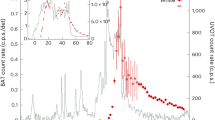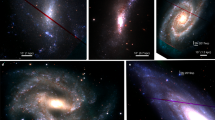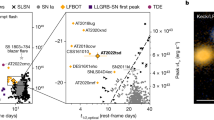Abstract
The complex wavelength dependence1–4 shown by the light curves of the AM Herculis type binaries such as 2A0311–227 (EFΔERI) and AM Her itself has led to suggestions5–7 that accretion occurs onto both magnetic poles of the white dwarf. The field strengths of the two poles being sufficiently different that one pole dominates at optical wavelengths, while the other produces most of the emission in the IR. Other authors3 have argued for a single pole model explaining the wavelength dependence of the light curves in terms of the rapidly changing cyclotron opacity with wavelength. An observational method of distinguishing between these two models is provided by the rapid flickering, which is a characteristic property of the light curves at both optical and IR wavelengths. We report here that the optical and IR flickering of 2A0311–227 are highly correlated indicating that in this object the dominant source of cyclotron radiation at both wavelengths is the same accretion column.
This is a preview of subscription content, access via your institution
Access options
Subscribe to this journal
Receive 51 print issues and online access
$199.00 per year
only $3.90 per issue
Buy this article
- Purchase on Springer Link
- Instant access to full article PDF
Prices may be subject to local taxes which are calculated during checkout
Similar content being viewed by others
References
Priedhorsky, W., Matthews, K., Neugebauer, G., Werner, M. & Krzeminski, W. Astrophys. J. 226, 397–404 (1978).
Jameson, R. F., Akinci, R., Adams, D. J., Giles, A. B. & McCall, A. Nature 271, 334–335 (1978).
Bailey, J. et al. Mon. Not. R. astr. Soc. 199, 801–815 (1982).
Bailey, J., Hough, J. H. & Axon, D. J. Nature 285, 306–308 (1980).
King, A. R. & Lasota, J. P. Mon. Not. R. astr. Soc. 188, 653–668 (1979).
Allen, D. A., Ward, M. J. & Wright, A. E. Mon. Not. R. astr. Soc. 195, 155–164 (1981).
Watson, M. O., Mayo, S. K. & King, A. R. Mon. Not. R. astr. Soc. 192, 689–696 (1980).
Bailey, J. et al. Nature 293, 204–206 (1981).
Motch, Ch., van Paradijs, J., Federten, H., Ilovaisky, S. A. & Chevalier, C. Astrophys. 110, 316–323 (1982).
Priedhorsky, W. C., Krzeminski, W. & Tapia, S. Astrophys. J. 225, 542–547 (1978).
Stockman, H. S. & Sargent, T. A. Astrophys. J. 227, 197–208 (1979).
White, N. E. Astrophys. J. Lett. 244, L85–L88 (1981).
Pattenon, J., Williams, G. & Hiltner, W. A. Astrophys. J. 245, 618–623 (1981).
Author information
Authors and Affiliations
Rights and permissions
About this article
Cite this article
Bailey, J., Hough, J., Gatley, I. et al. Simultaneous IR and optical light curves of 2A0311–227. Nature 301, 223–225 (1983). https://doi.org/10.1038/301223a0
Received:
Accepted:
Issue Date:
DOI: https://doi.org/10.1038/301223a0
Comments
By submitting a comment you agree to abide by our Terms and Community Guidelines. If you find something abusive or that does not comply with our terms or guidelines please flag it as inappropriate.



